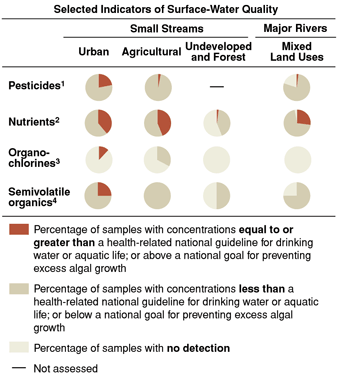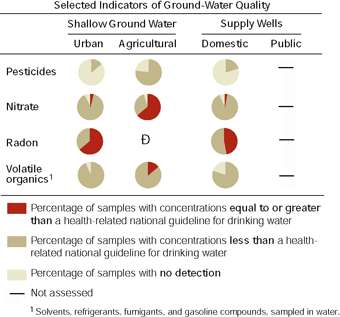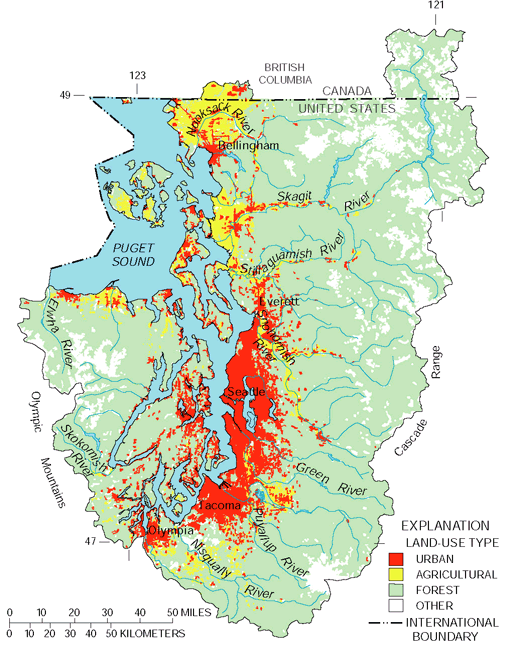SUMMARY OF MAJOR FINDINGS
Streams and rivers in the Puget Sound Basin met most Federal and State water-quality guidelines. In general, large rivers were more likely to meet guidelines than were small streams. Concentrations of fecal bacteria frequently exceeded U.S. Environmental Protection Agency (USEPA) recreational criteria and State standards protecting beneficial uses of surface water, and insecticide concentrations were occasionally higher than guidelines recommended to protect aquatic life. A total of 74 manmade organic chemicals were detected in streams and rivers, with different mixtures of chemicals linked to agricultural and urban settings. Though most chemical concentrations appeared to be low, guidelines for drinking water and aquatic life that are needed to make a full assessment do not exist for more than half the compounds detected.
- The insecticide diazinon, commonly used by homeowners on lawns and gardens, was frequently detected in urban streams at concentrations that exceeded guidelines for protecting aquatic life (p. 6).
- The average concentration of total nitrogen in small streams draining agricultural lands was twice the concentration in streams draining urban areas and over 40 times the concentration in streams draining undeveloped areas. Concentrations of total phosphorus were less dependent on land use, and concentrations above the USEPA desired goal of 0.1 mg/L to prevent excessive plant growth were detected in rivers and streams in all but undeveloped areas (p. 11).
- Concentrations of E. coli bacteria exceeded USEPA criteria for moderate water-contact recreation, including swimming, in 15 of 31 small streams. Livestock, pet, and wildlife wastes, and to some extent human sewage, are likely sources of these bacteria (p. 13).
- Urban expansion into forested areas is changing stream habitats, in part because of changes in water quality. Streams in urban and agricultural areas are warmer and support less diverse populations of insects than those in forested areas (p. 14).
 |
| 1 Insecticides, herbicides, and pesticide
metabolites, sampled in water. 2 Total phosphorus and nitrate (as nitrogen), sampled in water. 3 Organochlorine compounds including DDT and PCBs, sampled in fish tissue. 4 Miscellaneous industrial chemicals and combustion by- products, sampled in sediment. |
Trends in Surface-Water Quality
Concentrations of nitrate and phosphorus in the Nooksack and Green Rivers did not change between 1980 and 1997. During the same period, concentrations of nitrate in the Skokomish River and in Big Soos and Newaukum Creeks increased slightly (p. 12).
| Major Influences on Streams and Rivers
|
Reliance on ground water as a source of drinking water is increasing with urban and suburban development. With some exceptions, ground water is of high quality. However, as indicated by elevated concentrations of nitrate and the presence of pesticides and other organic compounds, shallow ground water in both urban and agricultural settings is vulnerable to contamination. Monitoring wells in urban residential areas generally contained low-concentration mixtures of chemicals associated with transportation and household activities. Shallow ground water, at depths tapped for domestic supply in agricultural areas, contained fertilizer residues (nitrate) at concentrations that commonly exceeded the drinking-water standard. Other agricultural chemicals were also frequently detected, though mostly at concentrations below current Federal and State drinking-water guidelines.
- Use of fertilizers on urban lawns and gardens and drainage from septic systems have elevated nitrate concentrations in shallow ground water beneath urban residential areas. In most samples, these concentrations were substantially less than the drinking-water standard (p. 17).
- Pesticides were not detected in wells that are more than 120 feet deep, the depth below which most large public-supply wells withdraw water. Pesticides were detected in wells that are less than 100 feet deep, the range of many rural and suburban domestic wells, but concentrations met drinking-water guidelines. Only about half of the detected pesticides have guidelines, and no benchmarks are available to assess the significance of low-concentration mixtures of pesticides (p. 16).
- Applications of fertilizers and dairy and poultry manure to cropland in agricultural areas of the Nooksack River Basin have increased nitrate concentrations above the USEPA drinking-water standard in about 60 percent of the shallow ground water sampled (p. 18).
- Prior to 1977, 1,2-dichloropropane was one of the ingredients in fumigants used on potatoes and berries in the Nooksack River Basin. Currently used fumigants contain only trace amounts of this compound, and their application is not likely contaminating ground water to concentrations exceeding drinking-water standards (p. 19).
 |
| Major Influences on Ground Water
|
| Table of Contents || Previous Section || Next Section || Glossary U.S. Geological Survey Circular 1216 Suggested citation:
|


